Hi all - I recently started a new sour dough starter via the clever carrot web article. Mine was a 100% hydration white flour starter, I am on day 10 I think and have made one average loaf and also made some earlier mistakes with feeding.
I am struggling with working out the starters routine. I've read tons of articles and watched lots of youtube videos but in all honesty I think rather than help I've ended up losing my way and over thinking this maybe.
I now have the starter in an environment that's around 23-25c (boiler cupboard) - and I am feeding it every 12 hours at 1:3:3. Currently this equates to 30g:90g:90g as I am too scared to lower the starter to less than 30g as its so new (not sure if that's anything to worry about but 30g seems safe to me at the moment).
My problem is I can't seem to work out the peaks, when its fresh, old etc and wondered if someone could help?
So as an example on the 25th at 10am I feed the starter (1:3:3). By 2pm it had doubled in size and had a slight dome.. I didn't get chance to check again but by 7pm the same day it was still double but I think with no dome (see photos below). So I assume that the peak would have been in between 2pm and 7pm and I missed it. For ref in each photo I have a black pencil line showing where it was when I fed it.
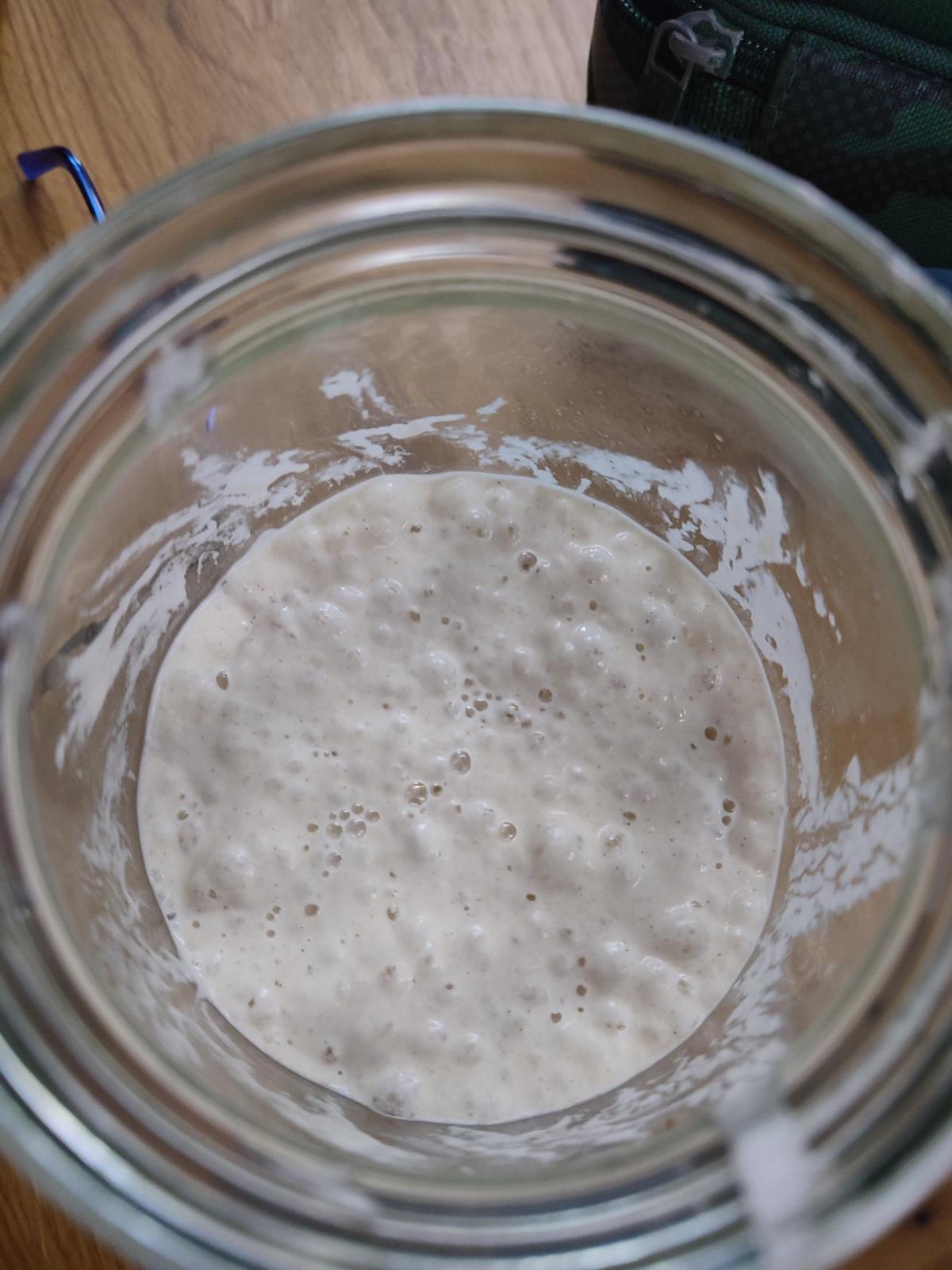
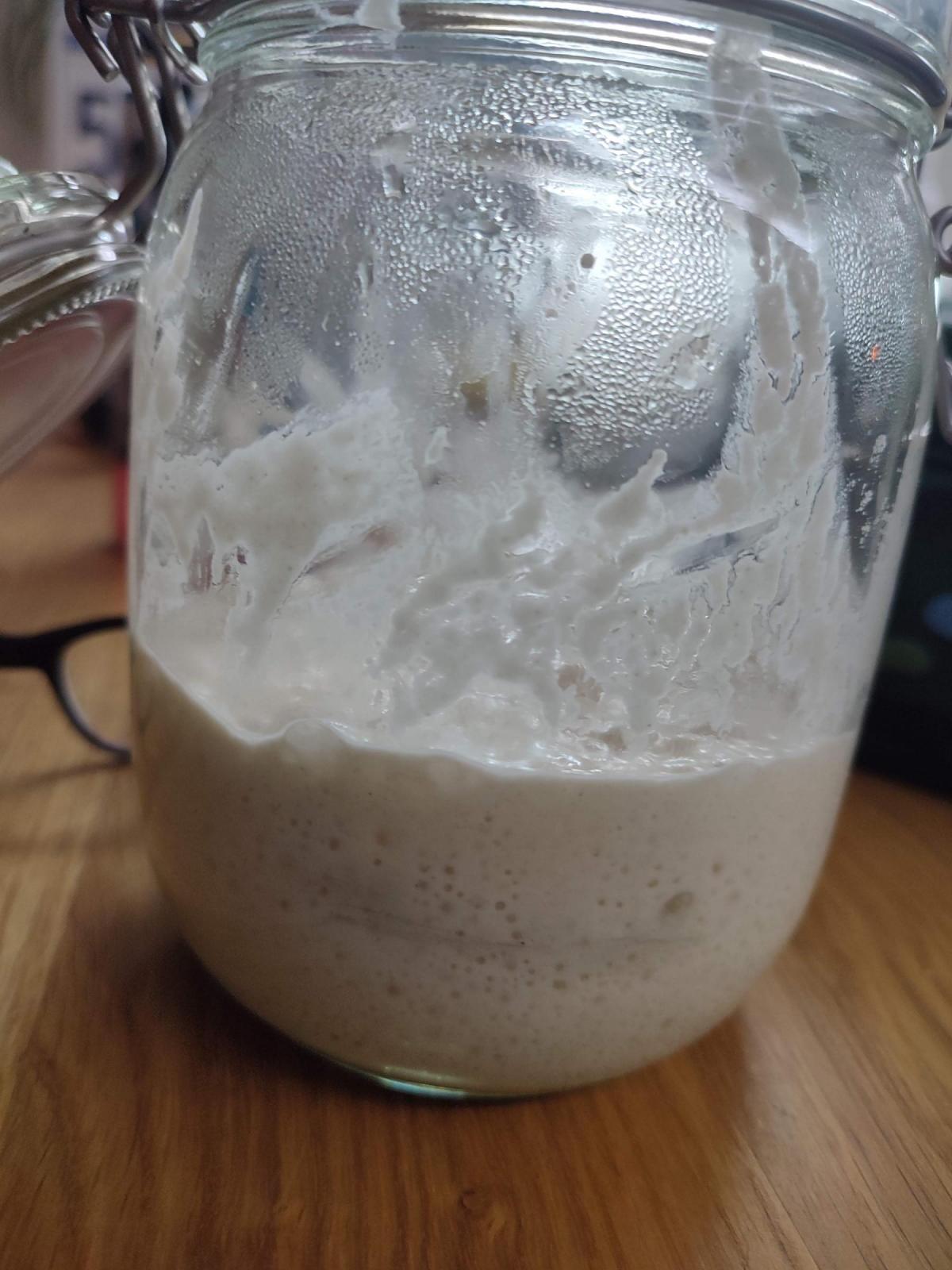
I fed it again at 10pm that night and then by 8am this morning it was maybe just under half and I'm not really sure what stage it was at (see photos below). It looks to me like its maybe past the peak as I can't see any clear dome. But.. it does pass the float test at this point still (although I don't think this is relevent).
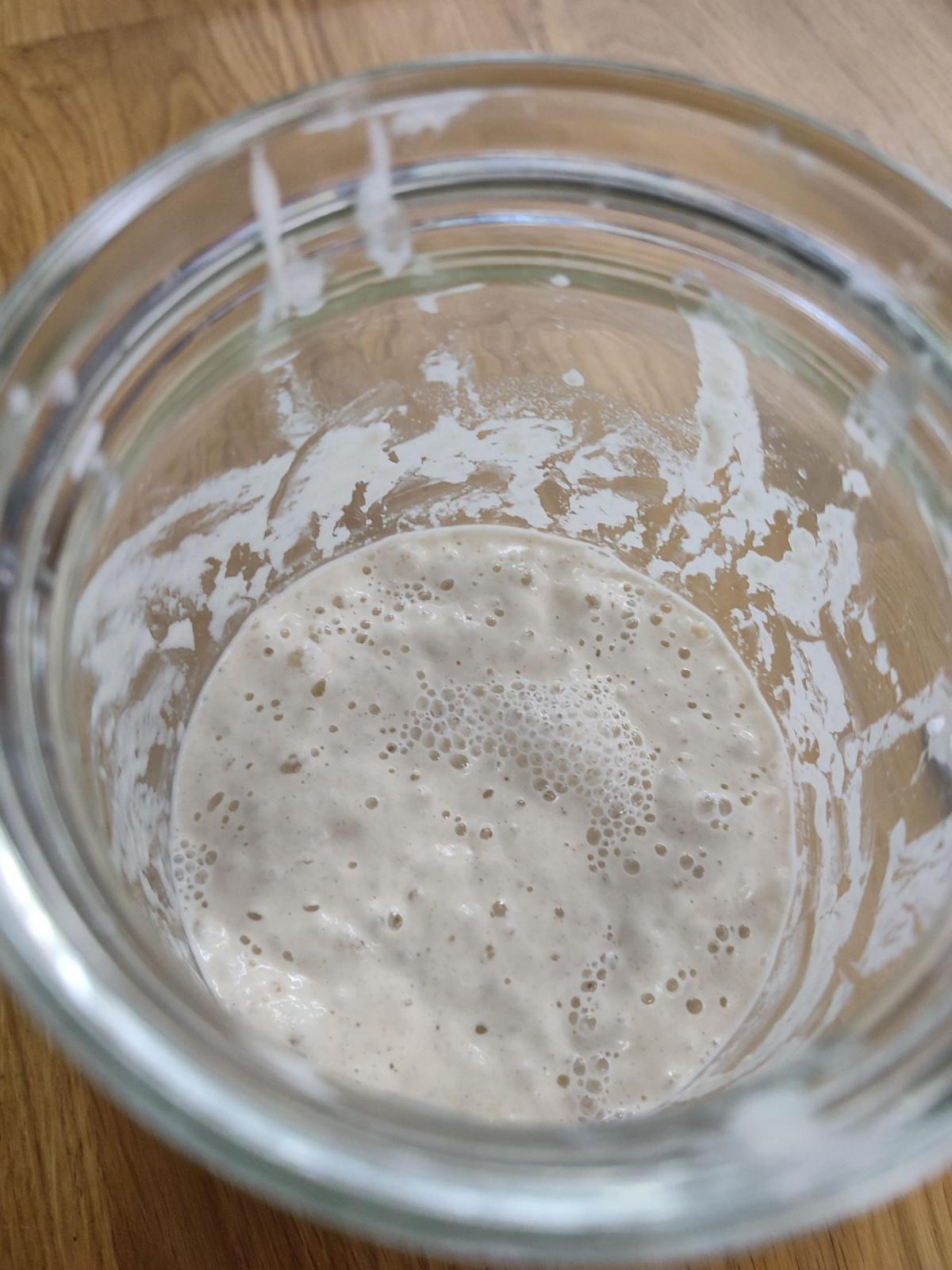
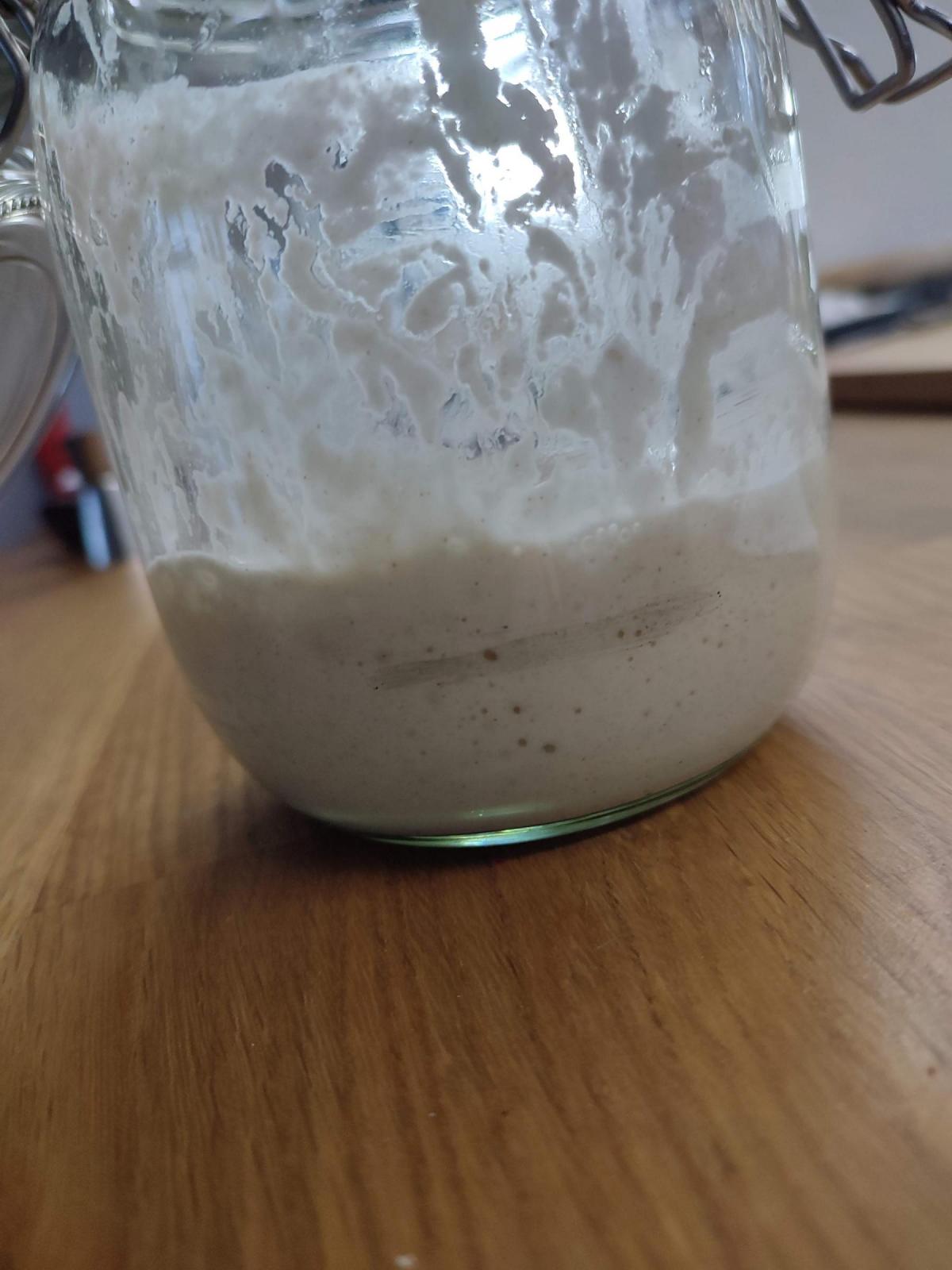
Right now @ 11:44am its much less below half and no dome (see below).. normally I'd feed it again as from what I read once it has peaked and begins to drop you can feed? Is that correct?
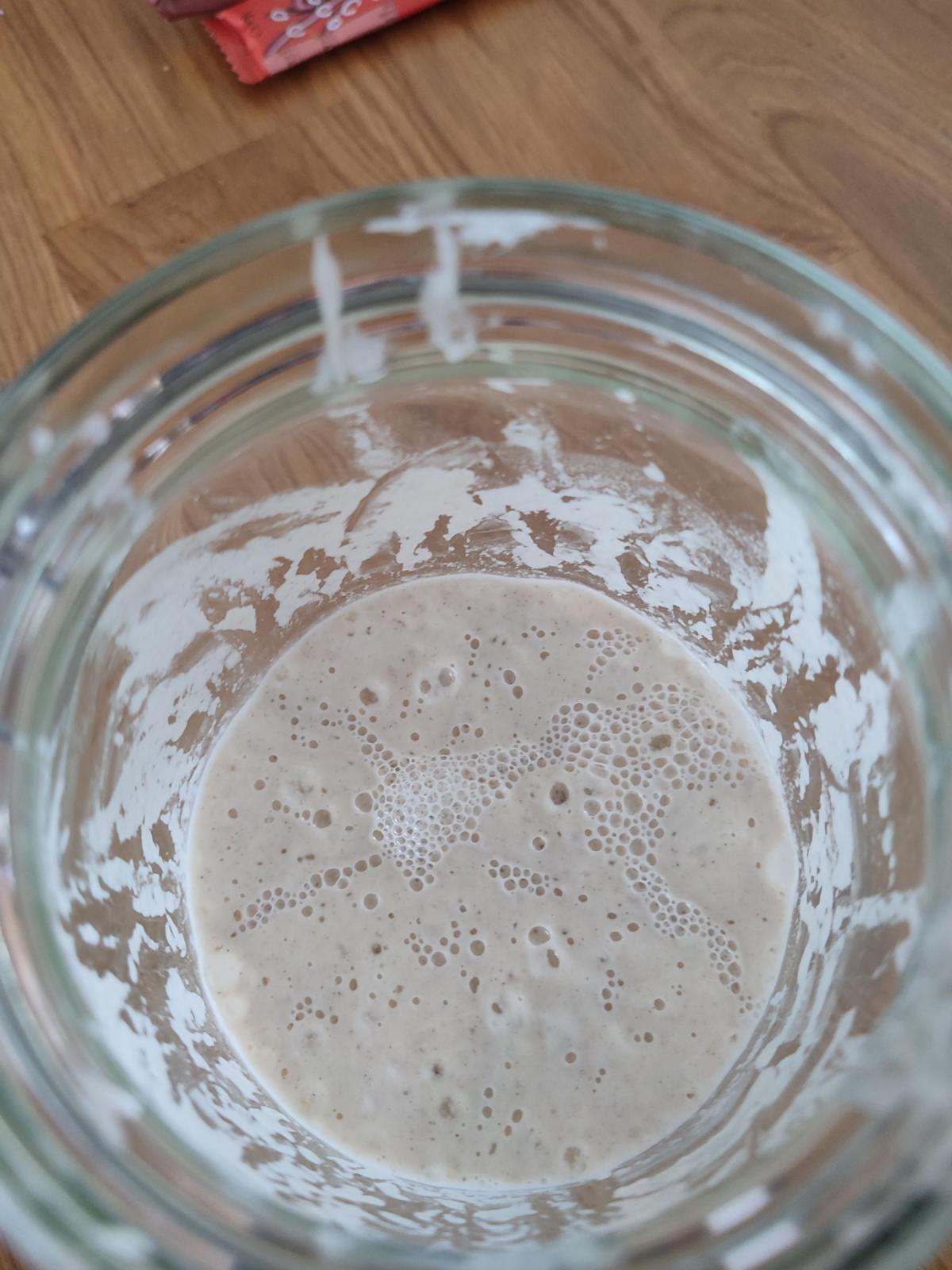
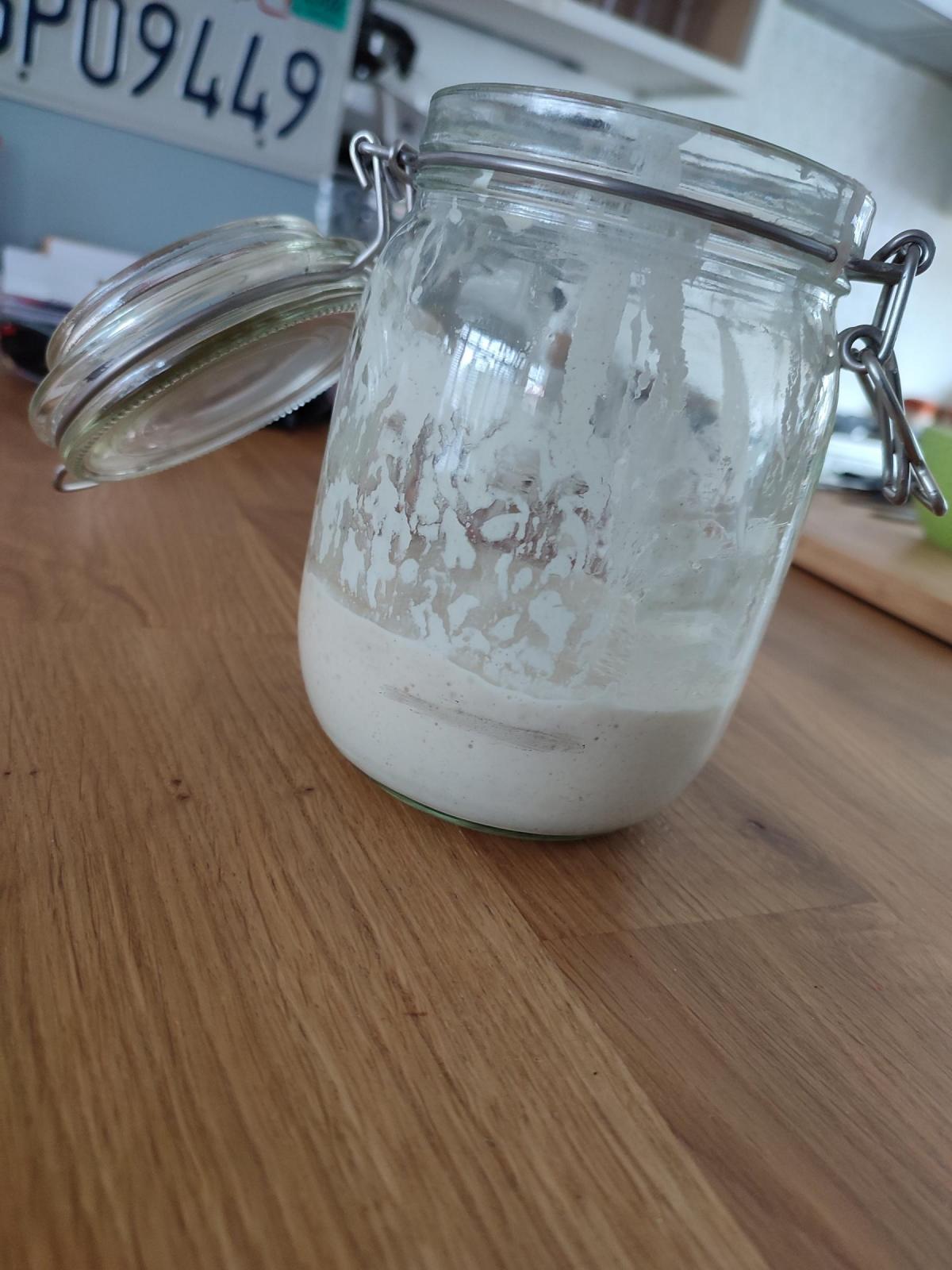
So to summarise I'm guessing the float test just tells you if it has air - not what stage its at as it passes this test young or old but in which case whats the point of the test really?
What I really want is to be able to tell the status of the starter. But also gauge timings with the right amount\ratio of feed so I can target just before peak for my baking and still fit in the schedule. So for example if I want to use it at 9am.. would the most efficient way be to feed it at 10pm the night before 1:2:2 then again at 7am (with the ratio I need for the recipe)? I guess before I can answer that I may need to work out how long its taking to peak exactly and not just roughly?
Hope this all makes sense! Sorry for the long post prob over thinking this!
Cheers
Tim
Started another test - discarded all but 25g of the starter and mixed with 75g (25c temp) water and 75g flour.
After 4.5 hours in an area around 24c its doubled in size but the float test is failing. So I guess despite the double size my starter isn't ready to bake. Will test again in an hour or do .. but is this normal as I thought 2-3 hours was the timing for starters to normally be ready?
Hi Tim, you are on the right track, actually! Your starter is almost there, almost ready.
Indeed, 3 hours at 25C would be enough for a starter to be ready (and to at least double if not triple in volume), but only if fed 1:1.6, for example, 100g starter, 100g bread flour, 60g water.
Your feeding is so generous, 25:150 which translates into 1:6, it would take a lot of time for the starter to be ready. This means 1) to reach the proper level of acidity 2) leavening power 3) volume ( for a 100% hydration starter made with bread flour it means 3.5-4x increase on volume).
See Jeffrey Hamelman's feeding schedule, for example, he feeds his starter ONCE a day, about 1:3.6,which in grams meas 10g starter, 20g wholegrain flour, 80g water, and he is a professional baker and baking instructor, his starter is used to bake extraordinary breads, literally millions of loaves, shown in his bestselling book.
Since you are doing microfeeds, try watching Kristen Dennis's instructional video where she shows how she "trains" her 100% hydration micro starter to rise 3.5-4x before feeding it and try her flour blend to stimulate your starter. It does not even double in volume right now before you feed it, so it is very diluted right now, very little yeast.
Thanks so much for replying - ahhaa i didn't realise the ratios made a difference to the speed of how quick its ready to bake!
I will check the schedule and also watch the vid thanks!
For ref I just checked again after and the starter after 6 hours now passes the float test and is maybe just over double volume. But of course 6 hours is too long for me I'd need to get up at 3am to feed it haha! Will go read\watch and hopefully work out a schedule for my starter.
Watching Kristen Dennis's video - I think maybe I need to go back to 1:1:1 as my starter is just doubling currently? Then wait until it gets more growth before moving to 1:2:2. Does that sound sensible?
Right now I guess I'm just trying to grow the culture and I'm obvs over feeding.. but my original thinking was more food more growth!
Edit: Actually I think I need to work out if mine is peaking and then dropping before 12 hours to decide if I should reduce from 1:3:3 that I am doing at the moment.
Yes, add 5-10% wholegrain flour to your white bread flour and feed lesser amounts for a day or two 2x daily.
Kristen keeps her starter at 80F/27C and yours is kept at 24-25C which significantly slows down things as well. 3C difference for a starter equates 50% less gassing power (slower rise and slower multiplication rate of yeast cells), 6C difference means 100% less gassing power and about half multiplication rate of yeast cells.
More food= more growth is right but only in terms of time. More food means that microbes might feed on that food longer, not that they would multiply faster. Only higher temperatures would make them multiply faster.
I feed my starter 1:1 (not 1:1:1, but 1:1, i.e. something like 1s:0.5f:0.5w) and it is ready in 6-12 hrs at 24-25C. It is a very powerful starter with tons of yeast in it. It doubles in one hour after feeding. So I have to stir it and let it rise over and over! It holds its peak volume steady for hours and floats even after 12 hours steady without sinking. You don't have to feed yours like that; it is only to illustrate that you do not need to add a lot of flour to feed your starter.
Thank you - I've bought some wholemeal flour as I couldn't find wholegrain in our UK supermarkets and when I googled it I think in the UK we call it wholemeal perhaps. I'll start a 10% additive to the white flour from tonight.
I've dropped to doing 5g:10g:10g from this morning and will see how we go.. I guess once I see a drop from peak 'before' the 12 hour point I should move to 5:15:15? Just like in the youtube video. And then go from there and try and build up the strength of the yeasts.
I do struggle to see if it has reached the peak and dropped etc I maybe need cleaner jar walls every time.
Thanks again
Sure. You can mix in one jar and ferment in another, this way you will have clean walls. From what I've seen in your photographs, none of your starters reached the point of falling.
You can also use weighed amounts of water in a jar to mark volume levels with a rubber band or thin strips of scotch tape before filling it with the starter to observe its rise. Narrow and tall little jars make it easier to observe.
Which flour are you using to feed your starter? If it's plain flour, then it will never rise high or stay tall for long, giving the starter time to accumulate yeast cells in large numbers. With plain flour, the method of observing the starter's volume and fall will not work. You need to use strong bread flour to see the explosive rise as in Clever Carrot's pictures.
Yeah thats a good idea thanks - I have tons of old jam jars and as I am now using smaller amounts this would work.
Well I was using Allisons strong white bread flour originally to build the starter. Then I switched to all purpose (plain) white flour after around 10 days..but I've now switched back to strong bread flour in the last day or so as I read it would be better. I'm still not seeing the explosive growth (just double growth max), but I'll carry on and start adding the wholemeal in and hopefully this will help.
If I don't get the action needed in the next week do you think I should start over with the wholemeal mix added right from day 1?
Hi Tim,
I now see where the problem lies. You are using UK flours in a US recipe (with US ingredients) and I gave you a link to the video that shows how to make a micro starter with US bread flour (and a bit of dark rye flour).
Our bread flour typically has a long list of ingredients. For example, RobinHood Best for Bread Flour that I use for my starter that quarduples in volume in 3-4 hours at 27C: Wheat flour, Amylase, Xylanase, Ascorbic acid, Niacin, Iron, Thiamine mononitrate, Riboflavin, L-Cysteine, Folic acid. I marked flour improvers in bold.
UK flours have no flour improvers added to them. It is up to the baker to add vitamin C and malt to it. Whereas in the US, millers add enzymes, vitamins, amino acids and malt to the flour, so it is already ready for use.
So, even if US flours have zero sugars in them, added enzymes (or malt) ensure that sugar content would rise during fermentation, steadily supplying microorganisms with simple carbohydrates needed.
Allinson's flour has zero sugars and no enzymes or malt added to it, so yeasts have nothing to eat. Yeasts thrive on sugar, they need it to grow in numbers and to live afterwards, to eat sugar and to produce gas. They cannot eat enormous starch granules or giant protein molecules, they eat small sugar molecules and small amino acid molecules which are "made" by enzymes (or malt, it has enzymes).
UK plain flours sometimes have enough sugar but too low protein, and sometimes high protein and no sugar, so you never know. For example, Homepride has 2% sugar but only 9%protein and no vitamin C added. The starter will be lively, but it won't rise high or stay tall for a long time:
I looked up Bakery Bits's starter sold in UK, they sell one white flour starter, and bingo! They say that they feed their starter once a day 1s:1f:0.8w (probably because they keep it at cool room temperature, below 20C) with Mulino Marino 00 Soffiata flour. It has no additives in it, but it has 2% natural sugars in it and a relatively high ash content (equivalent to T55 flour).
They say "we like Mulino Marino 00 Soffiata for this as it makes a very lively starter". Of course it does, It has sugar in it. And a very high protein content (a lot of strong gluten that can trap gas and rise very high and stay tall for hours non-stop without dropping).
Nutritional information / 100g
Thanks so much thats great info!
I've just checked the Allisons ingredients on the back of the strong bread flour pack - it has Amylase at least (which when I googled says it serves as the food for yeast).
But the Allisons wholemeal flour I have is much better the pack lists 12% protein and 1.4% sugars.
So while the bread flour has zero sugar my wholemeal isn't a million miles away from the Mulino flour above. I'll switch to 100% wholemeal and see how I go - I'll report back!
Thanks again
Tim
Tim, your idea is good, you can feed your wholemeal flour to your starter, it is very nutritious, microbes will love it! But do not expect it to rise too much or to hold its volume without collapsing. It's a very low protein flour, the wholemeal equivalent of plain flour, or cake flour. It will be wonderful in Irish soda bread, but not in sourdough.
In wholemeal flours, about half of all protein is locked in bran particles, they do not make gluten, they disrupt gluten. So, out of 12 g of protein per 100g, only six to eight grams are free to form gluten and try to trap gasses from fermentation.
Strong wholemeal flours, suitable for yeasted or sourdough breads, have at least 14-16% protein. For example, this blend of UK and Canadian wheats:
https://www.shipton-mill.com/products/strong-canadian-blend-wholemeal-flour-214
I wish you the best of success, Tim. Your starter looks good, it just needs the right flour with a lot of gluten and a pinch of sugar or malt to be more "yeasty", more active. If Allinsons atrong flour has malt, just blending it with 5-10% wholemeal flour will work wonders.
Your advice has been invaluable thanks - I think I've almost cracked it with the flour I have perhaps.
I tried 100% wholemeal last night and it grew by about 2.5x (the photo below was after approx 8 hours. Only problem was it seemed to runny despite me adding a slightly lower water content to feed (lack of protein I guess!)
So this morning I tried 50/50 of Wholemeal and Bread flour to try and get some more protein in mixed in. And after 2.5 hours its already 2.5 (perhaps 2.75) with a bigger dome than I've seen so far and its still rising! Its also seems much thicker but won't know for sure till I give it a stir later. Fingers cross this will do the trick. See photo below, can just about see the big dome.
I guess if this reaches almost 3 x thats good enough for Sourdough?
Thanks also for the link I'll order some higher protein flour for sure as this mornings experiment prooves its working better thanks to you. This one looks good from the same place perhaps? Organic Stoneground White Flour (119) (shipton-mill.com) Up to 13.9 protein and 16g sugars per 100g?
I'll post again with my results (just for any UK new bakers reading).
Thanks
Tim
Well I think it pretty much got to 3x - peaked and then dropped (can see the peak mark it left on the clean jar in the photo) this happened in about 5 hours. I'm not sure what time peak was I was out walking the dog. Is that activity good enough for sour dough now do you think once I've built up the strength a bit more? The texture is good also not runny any more and it passes the float test.
As I only want to feed it twice a day and its peaking before 5 hours now I assume I just need to raise the food to keep it going longer if left out of fridge? So if I'm doing 1:2:2 I need to jump to perhaps 1:4:4 to keep it peaked and building strength for 12 hours?
Eventually once its strong I wanted to use it once a week and store in the fridge.
Hi Tim, congratulations! You and your starter are both on the right track. That is simply wonderful, so good to see you succeed!
The light colored wheat flour from Shipton's that you linked is an amazing sifted wholemeal flour. Use it as an additive to Allisons strong flour to feed your starter. It is full of nutrition.
Test for doneness (whether the starter is good enough for sourdough baking).Once your starter peaks and begins to recede, stir it down to the initial volume and let it rise again, see how long it takes for it to double. If it doubles in one hour or sooner, it is mature (has enough yeast cells), you can either use it in breadmaking, or feed it, or simply store it in refrigerator until the next time.
As for your question about feeding twice a day. You can adopt one of two approaches:
1) feed it generously, so it peaks and begins to recede by the next time you feed it on schedule. You will have to find out the ideal feeding proportions for your flour blend, your timing (every 12 hours, or 8+16 hours, or any other combination that suits your daily activities) and your room temperature experimentally.
2) or keep feeding it as you are doing now, but stir it down each time it doubles and begins to recede, Let it rise to the max volume, stay there, begin to fall. Stir it down again and let it rise to the max again, etc. With strong flours, the starter can be stirred down and rise up again up to five times in a row without any change in performance, quadrupling each time. Only it will rise faster and faster as it accumulates more yeast, eventually doubling in 17-20 min. Professional bakers who feed their starters white bread flour twice a day, use that approach. They feed twice a day, 1:1:1 at moderate room temperature (about 20-22C), one batch ferments for 6-8 hours, another - for 16-18 hours.
Again, congratulations, Tim! Well done!
Godspeed.
m.